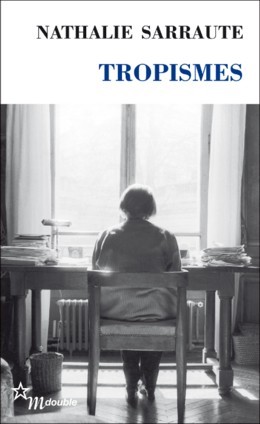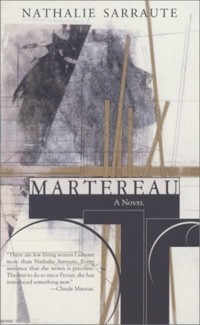
Is it an arch undertaking to breathe the name of such a brilliant writer as Nathalie Sarraute in the same phrase as a set of toothsome notches and a type of bacteria, as if to fashion a catchy rubric to catch the drooping eye of an interdisciplinary professor about to nod off on a heap of unmarked papers?
I am only imagining such a scenario, and here the red pen shall prick us not, but this hint of assonance reveals something. If we were to take the amiable blood and milk of our family bonds and examine it closely, even to a fault, for some slight imperfection that might suddenly spill and spread about our feet and envelop us within an organic cell of jagged points (fortunately all dulled into a continual Hammerklavier of seemingly innocent clichés and stock phrases), we might have a way of describing the experience of entering into one of Sarraute’s novels.

(The Age of Suspicion - George Braziller, 1990)
We are fortunate to have her excellent collection of essays on the novel form in The Age of Suspicion, partly because they offer great insight into her own writing methodology and style. Admittedly, the debate of the late 1940s between the psychological novel and the novel “in situation” has less resonance today. However, in her essay “From Dostoievski to Kafka”, which also appeared in Temps Modernes in October, 1947, she enumerates many gestures that make up recurrent characters in the works of the Russian novelist:
… all of these disordered leapings and grimacings, are the absolutely precise, outward manifestation, reproduced without indulgence or desire to please, the way the magnetic needle of a galvanometer gives amplified tracings of the minutest variations of a current, of those subtle, barely perceptible, fleeting, contradictory, evanescent movements, faint tremblings, ghosts of timid appeals and recoilings, pale shadows that flit by, whose unceasing play constitutes the invisible woof of all human relationships and the very substance of our lives.
One may go a step farther and consider that the stock character that had survived centuries with a modicum of security and self-preservation has in these novels (The Brothers Karamazov and The Idiot, especially) reached a point of such anxiety and abrupt expressions of unreliability that it appears inevitable the result would be the 20th century homo absurdus that Sarraute goes on to speak of, concerning Camus’ Meursault and Kafka’s various initials, those absurd characters without established identity or lineage. The characters of Dostoievksi perform abrupt about-faces and undermine the dramatic quality of their own pathos, and at times express awareness of their own aesthetic enjoyment, even as they cause continual ruination for those around them. Sarraute elaborates on the basis for their behaviour:
It is this continual, almost maniacal need for contact, for an impossible, soothing embrace, that attracts all of these characters like dizziness and incites them on all occasions to try, by any means whatsoever, to clear a path to the “other,” to penetrate him as deeply as possible and make him lose his disturbing, unbearable opaqueness; in their turn, it impels them to confide in him and show him their own innermost recesses.
Sarraute recognizes these faint shadings in the characters of Marcel Proust, although she finds they are perhaps in the thicker envelopes of their aristocratic milieu. It is worth mentioning that Proust’s much celebrated Baron de Charlus, at times charming and at times haughty, in spite of his racy adventures with footman and at masochistic hangouts, does exhibit this emotional need for an almost unbearable amount of contact, especially when he singles out the narrator as a kind of confidante, until he is struck down by what strikes me as the most genuine example of (unrequited) love in all of the seven volumes.

(There’s surely more to the Baron - John Malkovich in Raúl Ruiz's film Le Temps retrouvé - than whips, chains, and portholes …)
Having diagnosed the symptoms of these kinds of characters, Sarraute goes on to bridge the gap with Franz Kafka’s works, expressing her conviction that Kafka has isolated a particular element in Dostoievski’s Notes from the Underground, an element he has magnified and expanded to great extent in his books, citing examples in which characters are treated as objects or even insects. The fascinating part is Sarraute’s lengthy description of the Kafkaesque world, because it reads like one of her own novels, where quotidian experiences turn nightmarish through a repetition, a hammering of phrase after phrase that lead to personal annihilation. This is just the shortened form:
We all know this world … those who, when you ask them “if you can’t come to see them (because) you feel a bit lonely,” content themselves with giving their address “for your information, rather than as an invitation,” those who, if you come to sit beside them, say: “I shall be leaving,” … those who, one fine day, as Klamm did with the landlady—and without years and years, an entire life of uneasy reflection ever making it possible for you to understand “how it happened”—break off all connection with you, “never call you again and never will call you” …
The title essay, “The Age of Suspicion” (Temps Modernes - February, 1950) refers specifically to an age in which the reader can no longer trust all of the writer’s labour that has gone into building up a character, from attributes to personal history. The public wants an official document and nothing invented, and so to prevent it being “taken in,” only “true facts” will be the order of the day. I paraphrase this part a shade wryly, thinking of the current mania for variations of non-fiction or memoir, or if not these, authors who are quick to claim ownership of someone else’s “true story” that he or she, the author, needs to tell as soon as humanely possible in the form of a novel.
Sarraute goes on to explain how the means of expression vacate the writer in the middle of the story, as he or she is no longer able to write down such a sentence as “The Marquise went out at five o’clock.” for the now suspicious reader. Sarraute also discusses the shift to first person in many highly notable works, and such ambiguities introduced into texts that demand more of the reader than ever before. Of course, there are instances when she alludes to her own writerly methodology:
… as a result of an evolution similar to that in painting—albeit far less bold, less rapid, and interrupted by long pauses and retreats—the psychological element, like the pictorial element, is beginning to free itself imperceptibly from the object of which it was an integral part. It is tending to become self-sufficient and, in so far as possible, to do without exterior support. The novelist’s entire experimental effort is concentrated on this one point, as is also the reader’s entire effort of attention.
We are not so far from our bacteriological bio-weapon analogy when this literary suspicion is described as “one of the morbid reactions by which an organism defends itself and seeks another equilibrium.” In the following essay “Conversation and Sub-conversation” (Nouvelle Revue Française – January-February, 1956) pursues this difficulty for a writer in turning outward from oneself and presenting people, to make them come alive in books, and there is an extension of that need expressed by choice Dostoievskian characters, only experienced by the author. Then Sarraute speaks of an imaginary partner who emerges from out of our past experiences, urging on valuable fictional material, and goes on one of her wildly entertaining jags so representative of her novelistic style:
For this flesh-and-blood partner is constantly nurturing and renewing our stock of experiences. He is pre-eminently the catalyzer, the stimulant, thanks to whom these movements are set in motion, the obstacle that gives them cohesion, that keeps them from growing soft from ease and gratuitousness, or from going round and round in circles in the monotonous indigence of ruminating on one thing. He is the threat, the real danger as well as the prey that brings out their alertness and their suppleness, the mysterious element whose unforeseen reactions, by making them continually start up again and evolve toward an unknown goal, accentuate their dramatic nature.
All clear? In this essay, Sarraute places emphasis on dialogue, noting the existence of conversation and sub-conversation, and offering her somewhat offbeat conviction that Proust would intervene as narrator whenever these two types of conversation were not entirely harmonious. Sarraute also cites the works of “English” writers Henry Green and Ivy Compton-Burnett, the latter whom she feels has done much to present dialogue that exists “somewhere on the fluctuating frontier that separates conversation from sub-conversation.” While I do not pretend to fully grasp all of her points in this essay, it does occur to me that Sarraute’s own novels often make use of surface conversation, particularly phrases, that as the novel in question progresses, reveal a form of sub-conversation, hidden like a waiting snake bite under a broad plain flapping flower, that somehow hardens into its own surface, until the bit of surface conversation appears to have physical properties of its own.
Sarraute’s final essay in the book “What Birds See” (January, 1956) references the Ancient Greek story of Zeuxis, whose painted grapes attracted and greatly disappointed any birds who saw them and tried to partake of them. An intriguing comparison is drawn to some of the most lauded literary books that after several months or years are like the grapes, suddenly flat, lifeless, waxen. Sarraute is not denigrating the writers of these works, whom she still credits with talent, but she is differentiating their works from works that bear rereading. Even taking into account obvious technological changes since the 1950s, her ironical critique does touch upon our societal view of books as commercial objects and our contemporary view of them as mere things we may consume and then dispense with:
What difference does it make to them if these works are not destined to last? … Why stock works with an eye to an unknown future, however imperishable they may appear to be, when what is most urgent is to give immediate, effective aid to the humanity of one’s time. For a book to wear out when it has served its purpose is only natural and sound. We throw it away and replace it by another.
Sarraute also makes an excellent point about forward-thinking authors who may be considered arrogant and accused of being out of step with their own time and immediate environs because of their “dreams of posthumous conquest and glory,” arguing that such a perspective is necessary to overcome the loneliness and doubt and distress that can accompany such a life, and also to keep up courage, confidence, and the ongoing ability to persuade themselves that what they are alone in seeing is true and not a mirage or merely the result of some defect. Sarraute closes on an optimistic note, hoping
that the time is not far off when these maladjusted, lonely individuals should not only be allowed to work without being discouraged, but should even be encouraged to give in to their obsessions.

(Portrait of a Man Unknown - George Braziller, 1990)
In Jean-Paul Sartre’s introduction to Sarraute’s Portrait Of a Man Unknown, he attempts to explain the idea of a novel that challenges the form and limits of the novel, making free use of the term “anti-novel”:
These anti-novels maintain the appearance and outlines of the ordinary novel; they are works of the imagination with fictitious characters, whose story they tell. But this is done only the better to deceive us; their aim is to make use of the novel in order to challenge the novel, to destroy it before our very eyes while seeming to construct it … [s]uch is this book by Nathalie Sarraute: an anti-novel that reads like a detective story. In fact, it is a parody on the novel of “quest” into which the author had introduced a sort of impassioned amateur detective who becomes fascinated by a perfectly ordinary couple—an old father and a daughter who is no longer very young—spies on them, pursues them and occasionally sees through them, even at a distance, by virtue of a sort of thought transference, without even knowing very well either what he is after or what they are.
Sartre makes a pertinent observation here, as her own ventures “on the fluctuating frontier that separates conversation from sub-conversation” have this peculiar quality of being at once internalized and externalized to the point that the reader is often not certain whether her proffered snippets of dialogue are evidence of real occurrences or are merely taking place in the dimly lit theatre of a character’s (and the brightly lit theatre of the reader’s) mind. The organism senses that it is under attack and must defend itself at all costs, at times taking the leap into such logorrhea that the source of the attack is confused between loved ones, who like those choice characters of Dostoievski are in turns adoring, cloying, irritating, and menacing.

(Martereau - Dalkey Archive Press)
There is a fine example of Sarraute’s technique in her novel Martereau, as what begins as a friendly word of advice from a business man (in what might have been a stock scene about class values from many an era) to the title character, advising him to “hammer on the same nail,” turns into exactly what it describes, the tool turning into a threatening weapon, the phrase becoming the means to browbeat, bully, beat, and ultimately ruin Martereau. Of course, in this book, Sarraute projects this theory of a literary suspicion onto the narrator, who in turn projects his suspicions onto the actions and words of his uncle and the family friend Martereau, until he is no longer sure whether a simple business transaction, a favour no less, has resulted in a permanent breach based on his own suspicious inklings.

(The Planetarium - Dalkey Archive Press)
In Sarraute’s novel The Planetarium, there is more agonizing compartmentalization, more cellular serration, as a series of narrative sketches tell the story of a young married man’s obsession with taking possession of his aunt’s apartment, while at the same time trying to impress his literary icon, although his “one false move” of letting his father accompany him has torn his opportunity to shreds:
“Why, that’s my favorite bookshop,” she had said that to him, and from that moment on, for a long time, he had not gone there without hesitating, fearful, hopeful, smoothing his hair in front of the glass door, assuming an appropriate expression, letting his glance wander about, seeking refuge at the counter in the back room … It had become a privileged, sacred spot, one that was propitious to miracles … she might appear at any moment, she might come while he was reading, to take up her stand silently beside him … they would look at things together … and this, have you read this, do you know about this? leafing haphazardly … what do you think of it?
Ah yes, what do we think of it? Myself, I wish more of her novels were currently available in English translation, including her innovative and poetic Tropismes and the aforementioned Portrait of a Man Unknown, certainly one of her finest works. My attempts to outline her essays in The Age of Suspicion is also indicative of its rarity. Until another press after Georges Braziller picks up the gauntlet, I would highly recommend picking up the Maria Jolas translations of Martereau and The Planetarium from Dalkey Archive Press. If you can muddle through the French editions like me or presumably far better, then best get muddling tout de suite because Nathalie Sarraute has many startling ideas to offer readers and writers, even in our highly enlightened and awfully humane 21st century.
 unnormable posted this
unnormable posted this